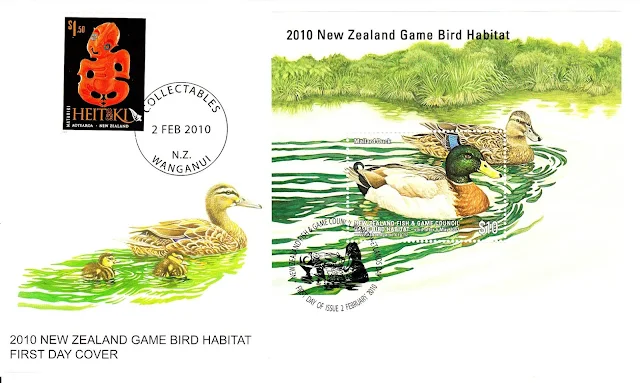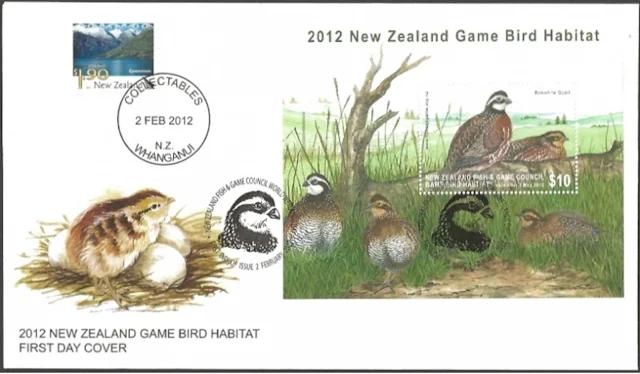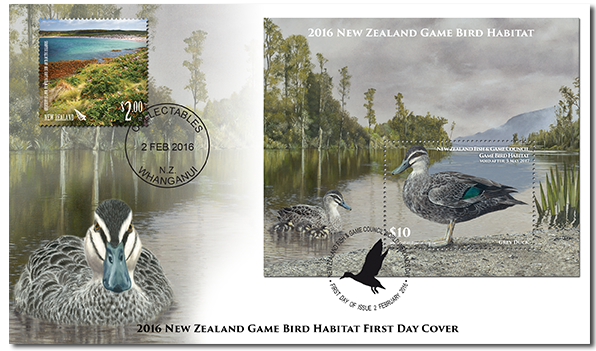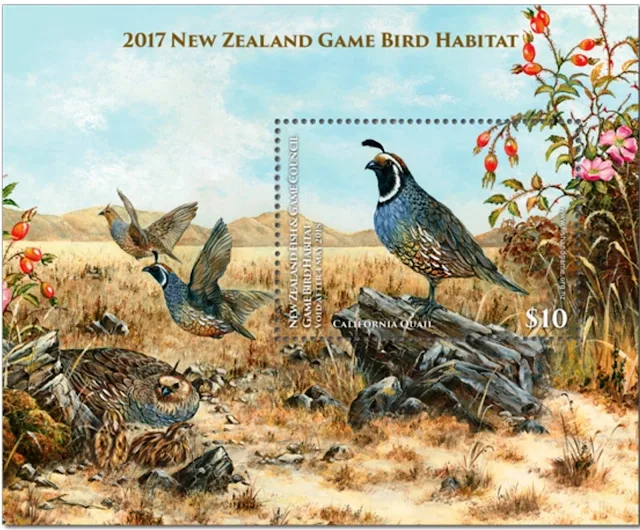 The New Zealand Game Bird Habitat Trust, established under the 1953 Wildlife Act, exists primarily to improve New Zealand game bird habitat, and secondarily to improve the habitat for other wildlife. The key purpose of the Game Bird Habitat Trust Board is to distribute funding for the development and enhancement of wetland habitat for the benefit of game birds and other wetland inhabitants.
The New Zealand Game Bird Habitat Trust, established under the 1953 Wildlife Act, exists primarily to improve New Zealand game bird habitat, and secondarily to improve the habitat for other wildlife. The key purpose of the Game Bird Habitat Trust Board is to distribute funding for the development and enhancement of wetland habitat for the benefit of game birds and other wetland inhabitants.The New Zealand Fish and Game Council commenced issuing $10 license stamps in 1994. The stamp is affixed to the game bird hunter's license thus validating the license for the current year. $2 of the license fee goes towards establishment and protection of Game Bird Habitats. The stamps and related products such as miniature sheets and First Day Covers are also marketed by NZ Post with funding received going back to the Habitat Trust.
This page will cover the stamps and all collector items for the year 2010 through 2019. In many cases, items may be missing but will be added when we find them. Consider this to be an on-going project that will be added to and improved as time goes on.
Game Bird Habitat Page One - 1994 - 1999.
Game Bird Habitat Page Two - 2000 - 2009.
Game Bird Habitat Page Three - 2010 - 2019.
Game Bird Habitat Page Four - 2020 - 2029.
2010 Game Bird.
2010 Mallard.
Mallard Ducks are common wild ducks that live in Northern Hemisphere wetlands. In New Zealand, mallards were released to supplement wild duck populations. Because introduced mallards are mating with the native grey duck and the proportion of pure grey ducks remaining is estimated at around five per cent.
Mallards feed by "dabbling" and upending, meaning that they tip their bodies into water, bill first, tail in the air, to forage for food. Their diet is 90% vegetarian, consisting mainly of seeds of grasses, sedges, pondweeds and other aquatic vegetation. Snails, insects and small fish sometimes are taken as well.
2010 Mallard Duck signed by the artist.
2010 Game Bird - First Day Cover.
2nd February 2010.
2nd February 2010.
2010 Game Bird - Miniature Sheet First Day Cover.
2nd February 2010.
2nd February 2010.
2011 Game Bird.
2011 Ring-Necked Pheasant
“Common” Pheasants were first introduced into New Zealand from Great Britain as early as 1842 but it was not until over two decades later that they became successfully established. One of the first successes was achieved in Canterbury in 1865, and other importations soon followed. In 1868 the Canterbury Acclimatisation Society bred forty birds and sold them to landowners for £2 a pair. The initial breeding was carried out in aviaries the aim was to establish self-sustaining populations in the wild.
According to Fish & Game New Zealand, the Ring-necked pheasant that is seen in the wild today is a hybrid of three breeds – Blacknecks, Chinese Ringnecks and Mongolian pheasants.
2011 Game Bird - Promotion Brochure.
2011 Game Bird - First Day Cover.
2nd February 2011.
2nd February 2011.
2011 Game Bird - Miniature Sheet First Day Cover.
2nd February 2011.
2011 Game Bird - Miniature Sheet
2012 Game Bird.
2012 Bobwhite Quail.
The least common of New Zealand upland game birds, the Bobwhite Quail was released from Auckland to Southland in 1898 and 1899. Today their range is much reduced but small numbers of birds persist in South Auckland and Northern Hawkes Bay. The populations of bobwhites are augmented with releases of hand-reared birds by enthusiastic aviculturists.
2012 Game Bird - Promotion Brochure.
2012 Game Bird - First Day Cover.
2nd February 2012.
2012 Game Bird - Miniature Sheet First Day Cover.
2nd February 2012.
2012 Game Bird - Miniature Sheet.
2013 Game Bird.
2013 Australian Bitten.
The Australasian Bittern (Botaurus poiciloptilus) is listed as nationally endangered, and while New Zealand is the stronghold for the species, there are still estimated to be fewer than 1,000 individuals living here. It is rare to see more than one bird at a time, and they are mainly found in wetlands in Northland, Waikato, the East Coast of the North Island and the West Coast of the South Island. Australasian bitterns or matuku are mottled brown with cream throats, long legs and long necks. They are extremely shy birds and often hide among raupo and reeds, standing stretched upwards when disturbed to merge with their reedy surroundings. They can look down even when holding their head high – ready to spot fish, frogs and eels to feed on.
2013 Game Bird - Promotion Brochure.
2013 Game Bird - First Day Cover.
2nd February 2013.
2013 Game Bird - Miniature Sheet First Day Cover.
2nd February 2013.
2013 Game Bird - Miniature Sheet.
2014 Game Bird.
2014 Pukeko.
The pukeko is a large, conspicuous rail found throughout New Zealand. The head, breast and throat are deep blue/violet, the back and wings are black, and the under-tail coverts are conspicuously white. The conical bright red bill is connected to a similarly coloured ‘frontal shield’ ornament covering the forehead, the eyes are also red. Females are smaller than males but similarly coloured. Juveniles are similar to adults but duller, with black eyes and black bill and shield that turns red around 3 months of age.
Pukeko are primarily vegetarian, but animal foods make up a small proportion of the diet. Most common foods are the stems, shoots, leaves and seeds of grasses. They also eat garden vegetables and crop plants. Animal foods consist mostly of insects, spiders and earthworms, however, there are rare reports of pukeko taking larger prey such as frogs, lizards, fish and nestling birds.
This stamp is shown in our post How the Kiwi Lost His Wings.
2014 Game Bird - Promotion Brochure.
2014 Game Bird - Miniature Sheet.
2015 Game Bird.
2015 Black Swan.
The black swan (Cygnus atratus), also known as the kakīānau, is one of the most common waterfowl found in New Zealand, with a population of approximately 50,000 across the country. Mainly found on lakes, estuaries, harbours and freshwater ponds, black swans are a legal game bird in most parts of New Zealand.
The black swan is covered in jet black feathers, with striking white feathers visible beneath the wings of adult swans The black swan has a bright red bill with a white band, red eyes and light grey legs. There is little difference between the male and female birds, though the females tend to be smaller. Black swans are slow, yet graceful swimmers on the water and tend to be territorial on land.
The nesting season for black swans generally occurs in the winter months from around July, with colonial nesting beginning around September through to November. Black swans are mostly monogamous and pair for life, usually nesting in the same spot each year, tending and rebuilding their nest as necessary. A typical breeding season will yield between four and eight eggs, with an incubation period of around 40 days. Black swans defend their nests, aggressively attacking any intruder with their wings and beaks.
2015 Game Bird - Promotion Brochure.
2015 Game Bird - Miniature Sheet.
2016 Game Bird.
2016 NZ Grey Duck.
The grey duck (Anas superciliosa) is a species native to New Zealand, but due to competition and hybridisation with introduced mallard species, there are no definitive population numbers for pure grey ducks. The grey duck, which is also known as the pārera, is commonly found in remote, shallow wetlands and streams with extensive riparian cover. They tend to be found in singles and in pairs in the wild (although can be found in flocks of mallards too) and are easily spooked.
The male and female are similar in appearance, with the male being slightly larger than the female. Both sexes have brown feathers that range from dark brown to light brown; the head is a lighter brown with a black crown and two distinctive black facial stripes. The grey duck has a grey beak, khaki legs and an iridescent green speculum with a pale underwing. Both the male and female can be easily confused with the female mallard due to their similarities in appearance.
The grey duck nests from around September through to December and is seasonally monogamous. The females lay and incubate the eggs and raise the ducklings, while the males tend to defend the territories to protect the females. The females typically lay eight to ten eggs in a season, which incubate for 26 to 29 days. The ducklings accompany the female duck for around seven to nine weeks and can breed in their first year.
2016 Game Bird - Promotion Brochure.
2016 Game Bird - First Day Cover.
2nd February 2016.
2016 Game Bird - Miniature Sheet First Day Cover.
2016 Game Bird - Miniature Sheet.
2017 Game Bird.
2017 California Quail.
The California quail (Callipepla californica) was first introduced into New Zealand in Papakura in 1862. Since then they have spread rapidly and can now be found in large numbers from Northland to the Waikato, inland Bay of Plenty, the West Coast and Southland. Their preferred habitats in these areas are open shrubland, the thick undergrowth of forests or along the scrubby edges of rivers and roads.
California quail can be easily recognised for the curling black plume that rises from the tops of their heads. They are relatively stocky birds and are mainly grey and brown in colour. The males have black faces that are rimmed with white and a blue-grey breast. They also have distinctive black scalloping that merges into white streaks on their dark brown flanks. The females’ markings are much more subdued, they tend to be a duller brown but their white streaks are equally as bold as the males.
When it comes into breeding season, male California quails can become quite aggressive in their courtships and will often fight each other. When courting, males will puff up or contour their feathers, spread their tail feathers and dip their heads. California quail nests are well concealed amongst dense vegetation and a flattened grassy area is the tell-tale sign of a nest. The striped walnut-sized chicks are extremely active and after hatching they will leave the nest as soon as they are dry. The chicks can also fly from a young age, giving them a useful escape tool from potential predators.
2017 Game Bird - Miniature Sheet.
2017 Game Bird - Miniature Sheet - First Day Cover.
2nd February 2017.
2nd February 2017.
2018 Game Bird.
2018 Mallard.
This is the 25th Game Bird stamp and the third time the Mallard Duck has been featured in this series, having already been seen in 2000 & 2010. The 2010 Mallard is also used as the title stamp for this page.
The mallard duck is the most commonly seen game bird in New Zealand. Its introduction to the country began with a series of importations from England between 1870 and 1930. The mallard duck can be found just about anywhere that water is present, from slow-moving rivers, hydro-dams and estuaries to public parks, urban water features and botanic gardens.
Crossbreeding with grey ducks has meant that the mallard in now less vivid and less distinctive than its Northern Hemisphere cousin. The male is easily recognised by its deep-green, glossy head and prominent chestnut breast. It’s around 10 per cent larger than the female, with mainly grey body plumage broken by striking blue secondary flight wings. The female’s rather plain, somewhat speckled plumage is brightened with a vivid blue stripe that is best shown off during flight.
2018 Game Bird - Miniature Sheet.
2019 Game Bird.
2019 Chukar.
A species of partridge, chukars are found primarily in the high country of the South Island. The current population is presumed to be a hybrid of two forms imported from different parts of Asia in the early to mid-20th century. Despite efforts by Fish and Game New Zealand and other groups to boost the population, numbers appear to be in decline.
The chukar, or chukar, (Alectoris chukar) is named after its distinctive ‘chukar-chukar’ crow.
The chukar has a medium-sized, round body, with a bright red bill and reddish-pink legs. Its plumage is made up of grey, black, white and chestnut feathers, with a distinctive black band that runs across the forehead and eyes and down the side of the neck, joining at the breast.
2019 Game Bird - First Day Cover.
2nd February 2019.
2nd February 2019.
2019 Game Bird - Miniature Sheet.
2019 Game Bird - Miniature Sheet First Day Cover.
2nd February 2019.
2019 Game Bird - Limited Edition Print.









































We appreciate your engagement with our content. To ensure a respectful and constructive community, please take note of the following:
- No Spam, Please: We do not tolerate spammy or promotional comments. Any such comments will be promptly removed.
- Moderation in Place: All comments are moderated to maintain a positive and inclusive environment. Please be patient, as it may take a little time for your comment to appear.
- Sign In with Google: To comment, please sign in using your Google account. This helps us maintain the integrity of our community and allows for better interaction.